Thinking about Thinking
Every problem contains within itself
the seeds of its own solution.
Stanley Arnold
“ The world as we have created it, is a process of our thinking.
it cannot be changed without changing our thinking.
Albert Einstein
“ Stop thinking and end your problems.
Lao Tzu
One might be tempted to believe that “thinking” (whether individually or in groups) is a quite natural process, which does not require any special precaution. However, science (neuropsychology, behavioural economics, etc) has shown that we must be very careful and not overestimate our cognitive abilities.
In firms, experience tells that “thinking” and “thinking in group” can easily go off-track and therefore needs to be guard-railed.
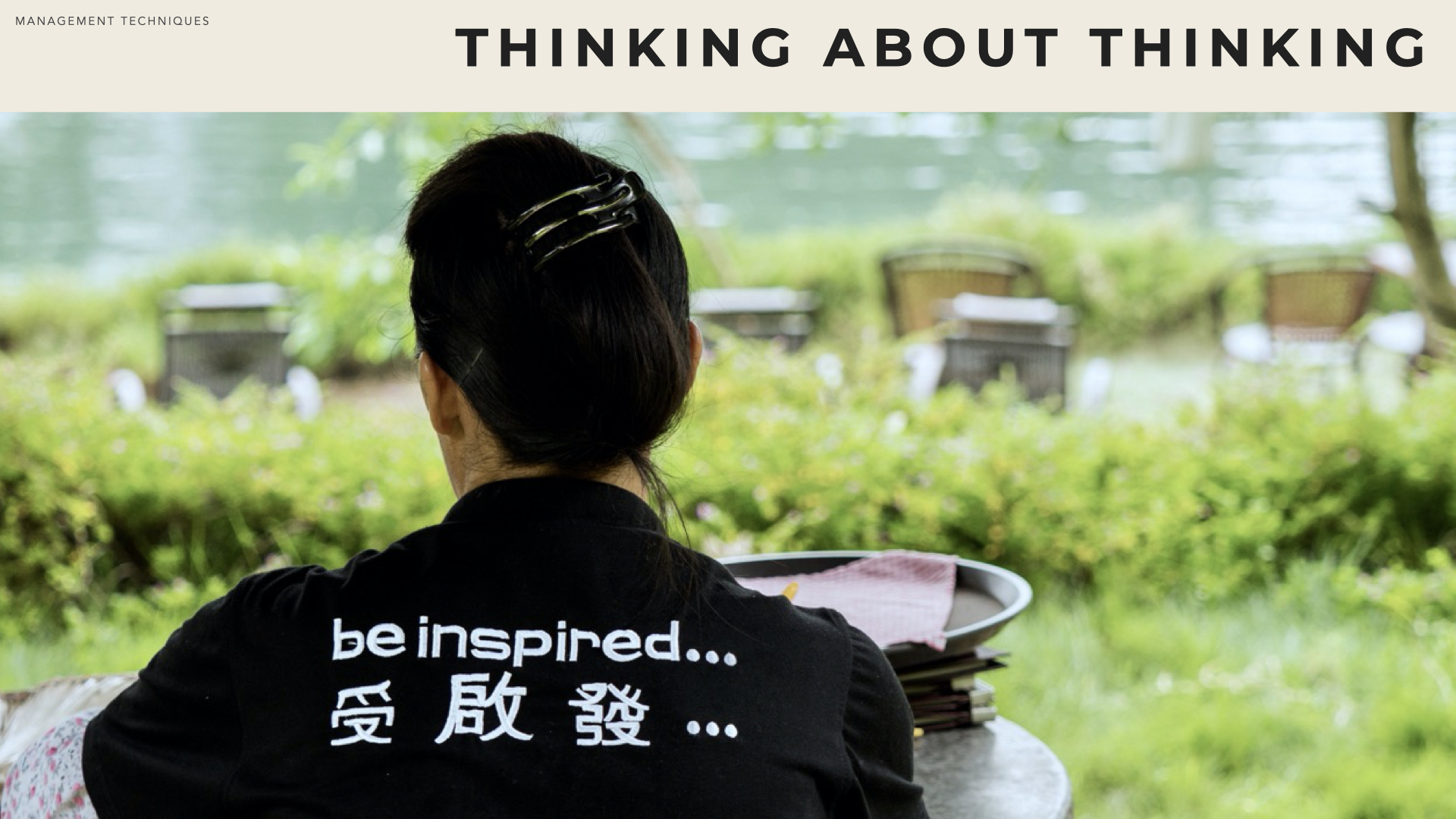
Why a Thinking method?
At individual level, we tempt to jump too quickly to conclusions (we disregard facts and trust too much our beliefs, we overcome the “blank page syndrome” by picking the first solution available). We may also struggle to consider the comprehensive picture as our attention can be distracted or on the contrary too much focused. More generally we fail prey to many cognitive biases and we must question our ability to make rational decisions.
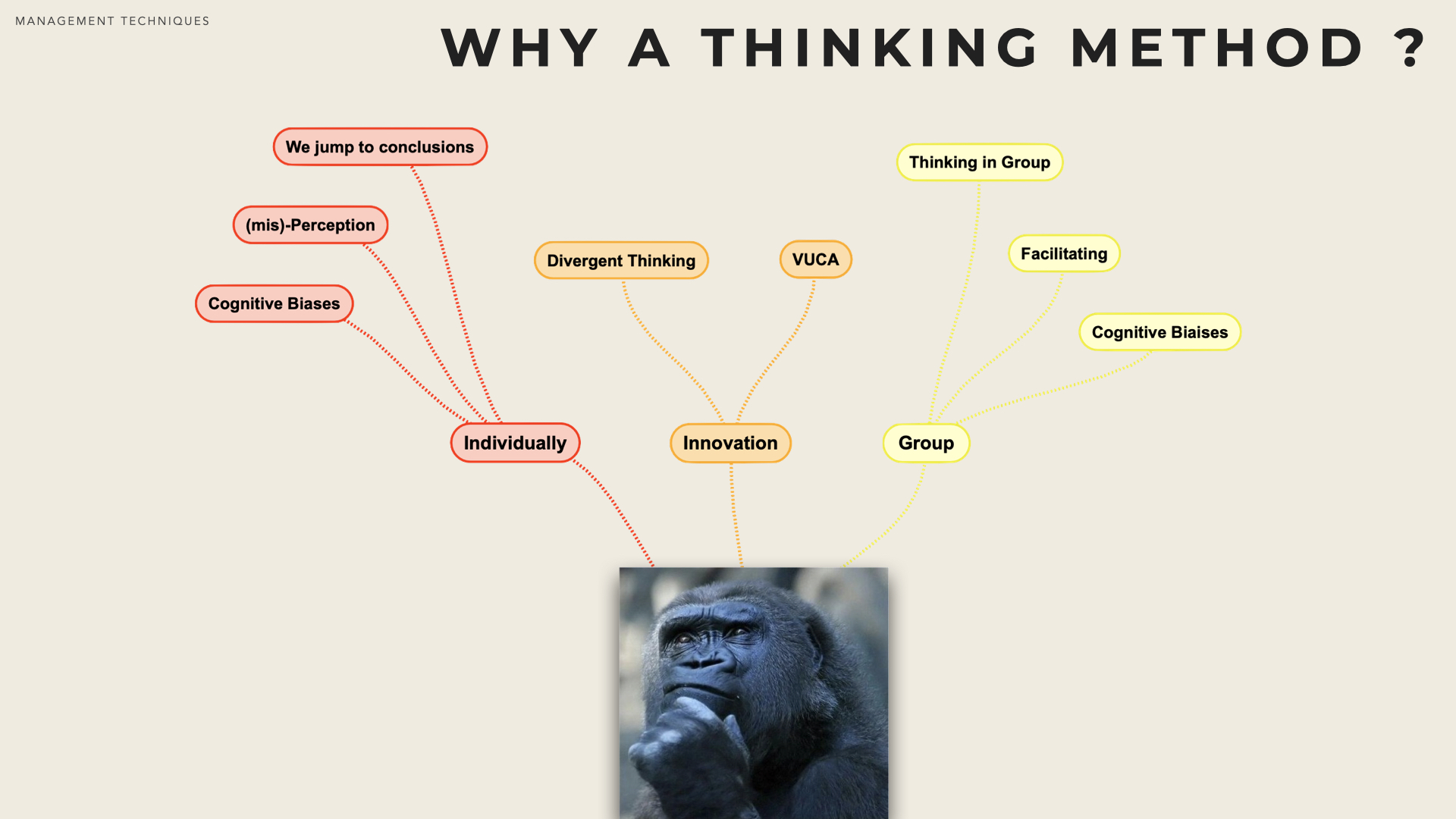
In many circumstances, we must depart from pure “western-thinking canons” (focussing on consistency and the logical flow of thinking) to foster creativity and divergent thinking.
The situation with thinking in groups is not simpler. The social interaction between the members of a group is playing a role in the thinking process and even sometimes, taking precedence.
Rational thinking, really?
Accessing and Processing information is costly
Homo economicus, the rational thinker portrayed by micro economics, is deemed having access to all relevant information and capable of infinite cognitive processing.
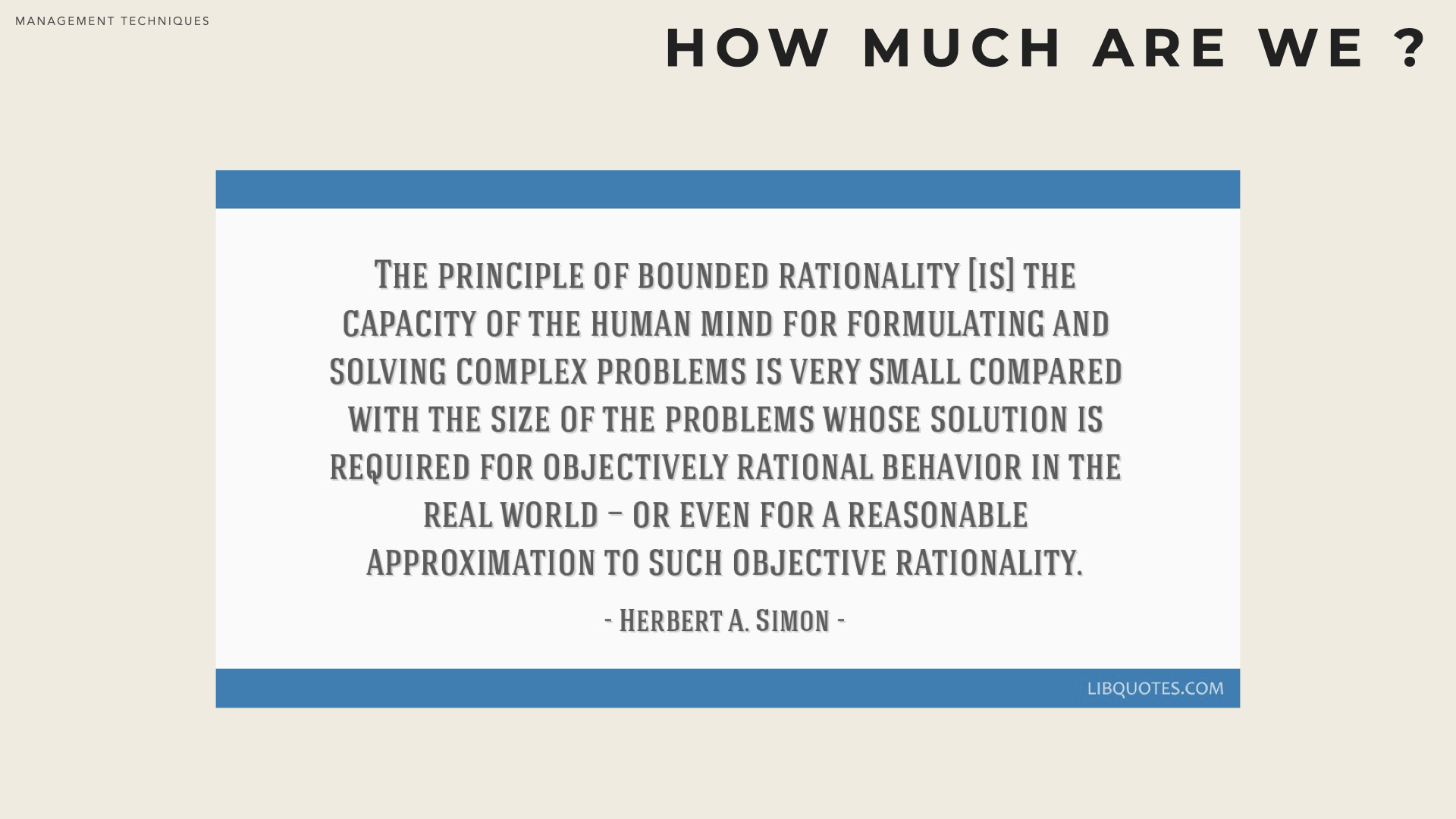
Real-life thinkers are different in so that information are missing and/or costly to obtain, furthermore, our cognitive abilities are limited. Behavioural economics ( [Kahneman11] [Angner16] [Dhami19] ) shows that we, human being, systematically (but unconsciously) deviate from rational thinking. Instead we use heuristics (approximate reasonings) or make big mistakes in reasoning.
Don’t jump too quickly to conclusions
To a large extend, our structures of thought are conditioned by our culture and education. For instance, traditional western thinking mainly hinges upon logical reasoning which has been the basis of the development of modern science.
As a result, western thinkers, tend to give a conclusion first and then bring in the facts to demonstrate that conclusion. The problem starts when thinkers don’t realise that their conclusion is not the result of a deliberate thinking problem.
Intuition can be very fruitful and useful, but it should not be confused for reasoning.
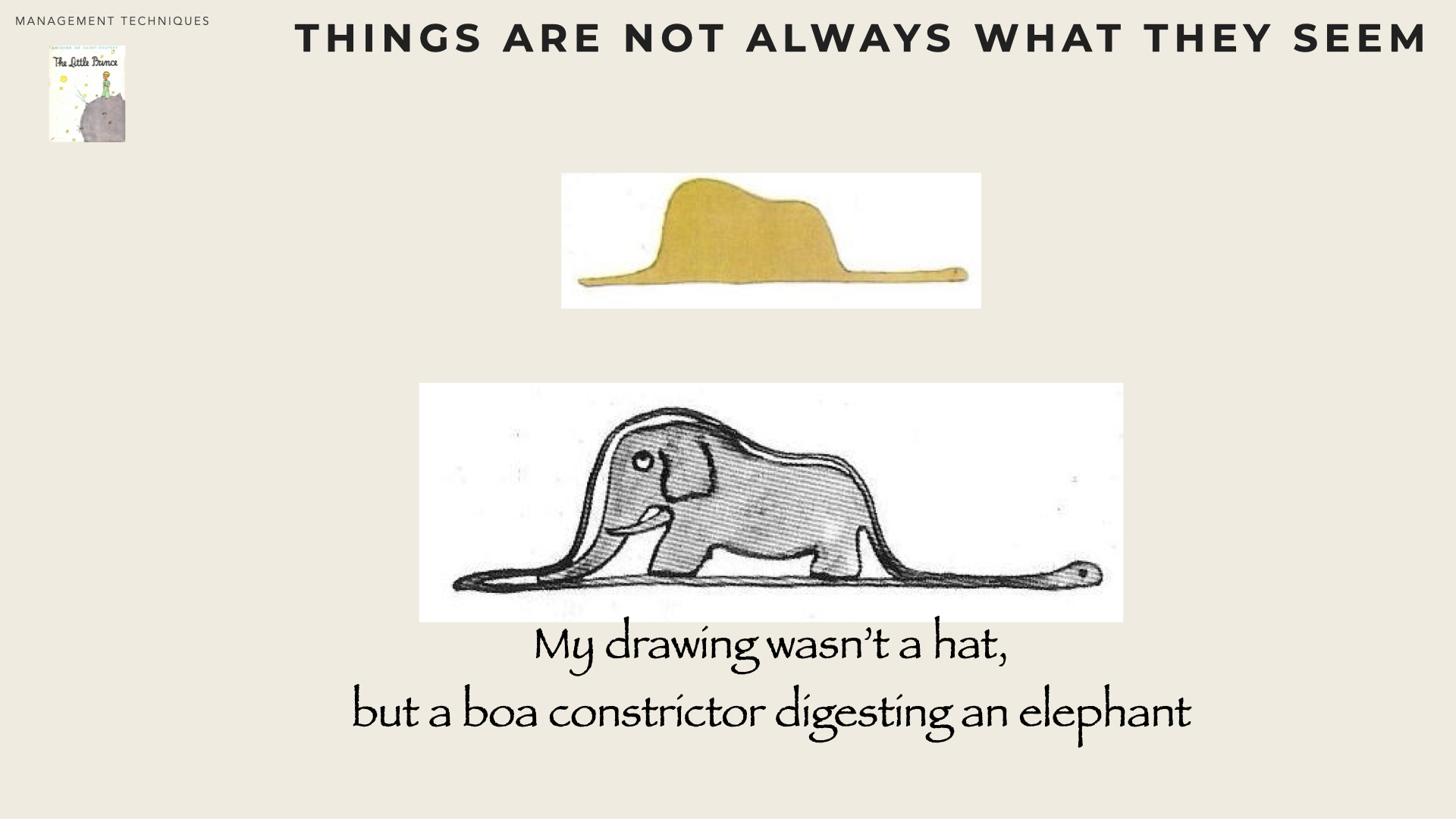
Unconsciously, this may deprive us of whole swathes of information and work like eyelashes far too quickly in the thinking process. This can obviously be detrimental when creativity is required, but even in more conventional thinking it may lead to completely wrong conclusions.
An explicit thinking method allows a more comprehensive and thorough appraisal and limit the censorship of new, potentially unusual and disturbing ideas.
Several perspectives but one at a time
If we seek to address several aspects of thinking at the same time or in a chaotic manner, we are going to be suboptimal on all of them, at best. While most people can consider various thinking perspectives, very few can successfully do it simultaneously.
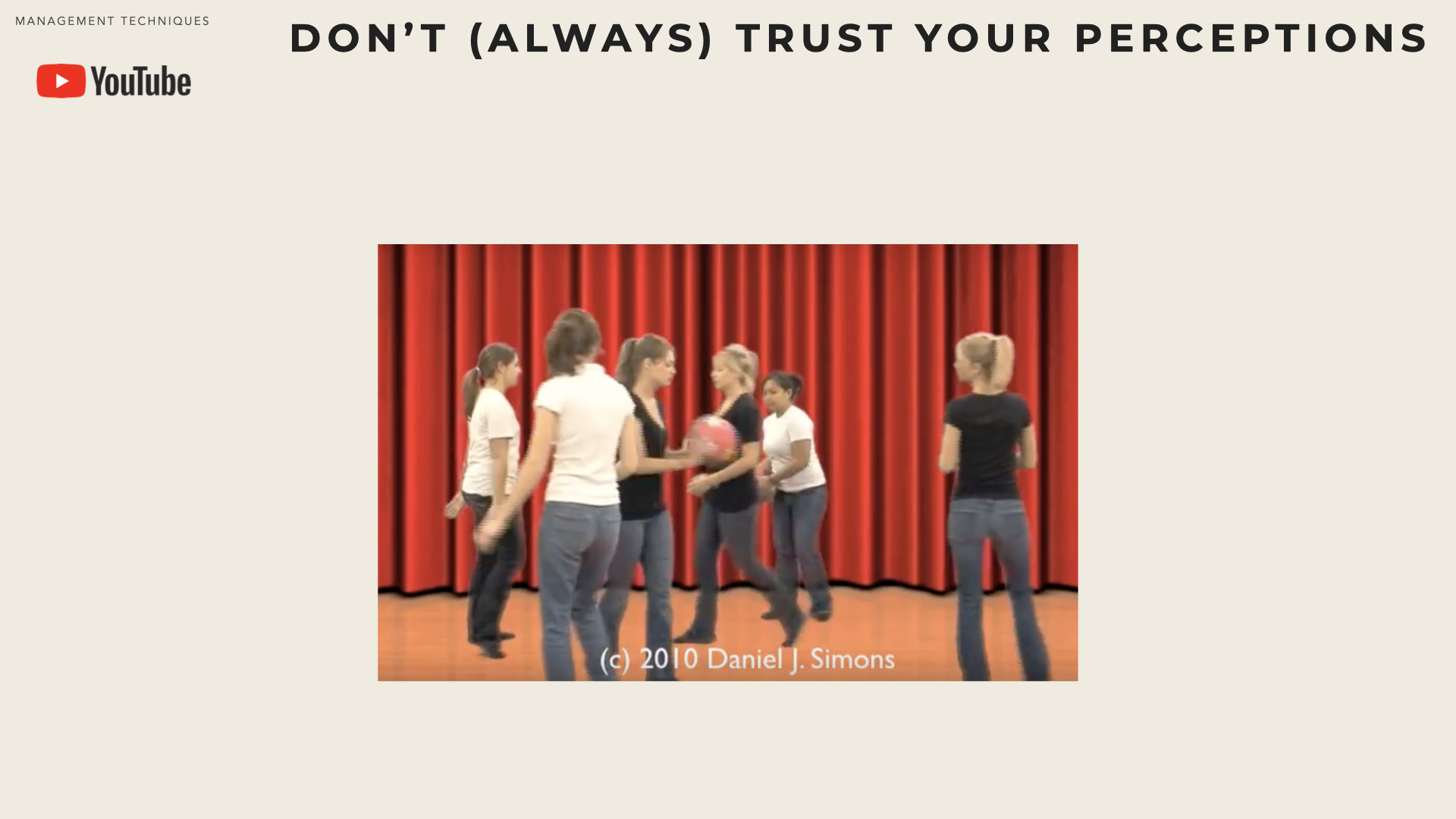
In addition, research in Attention Control established that people who are focussed on one thing can easily overlook something else ( [chabris11] ) . This is illustrated with humour, in this now famous video.
The difference between a good thinker and a poor thinker, often lies in the ability to focus. The important thing about focus is that it should be spelled out in a definite manner (about what subject? With what perspective?) – E. de Bono
An explicit thinking method ensures that the different viewpoints will be addressed while avoiding lacking focus, missing pieces of information or the unproductive dissipation of efforts.
Cognitive biases
Behavioural economics ( [Kahneman79] [Levitt05] [Ariely09] [Ariely12] [Gilboa11] [Jeffrey83] [Wakker10] ) has shown that the rationality of decision makers is bound: we often are missing some information and in addition, we are making systematic errors that arise from the way we process information.
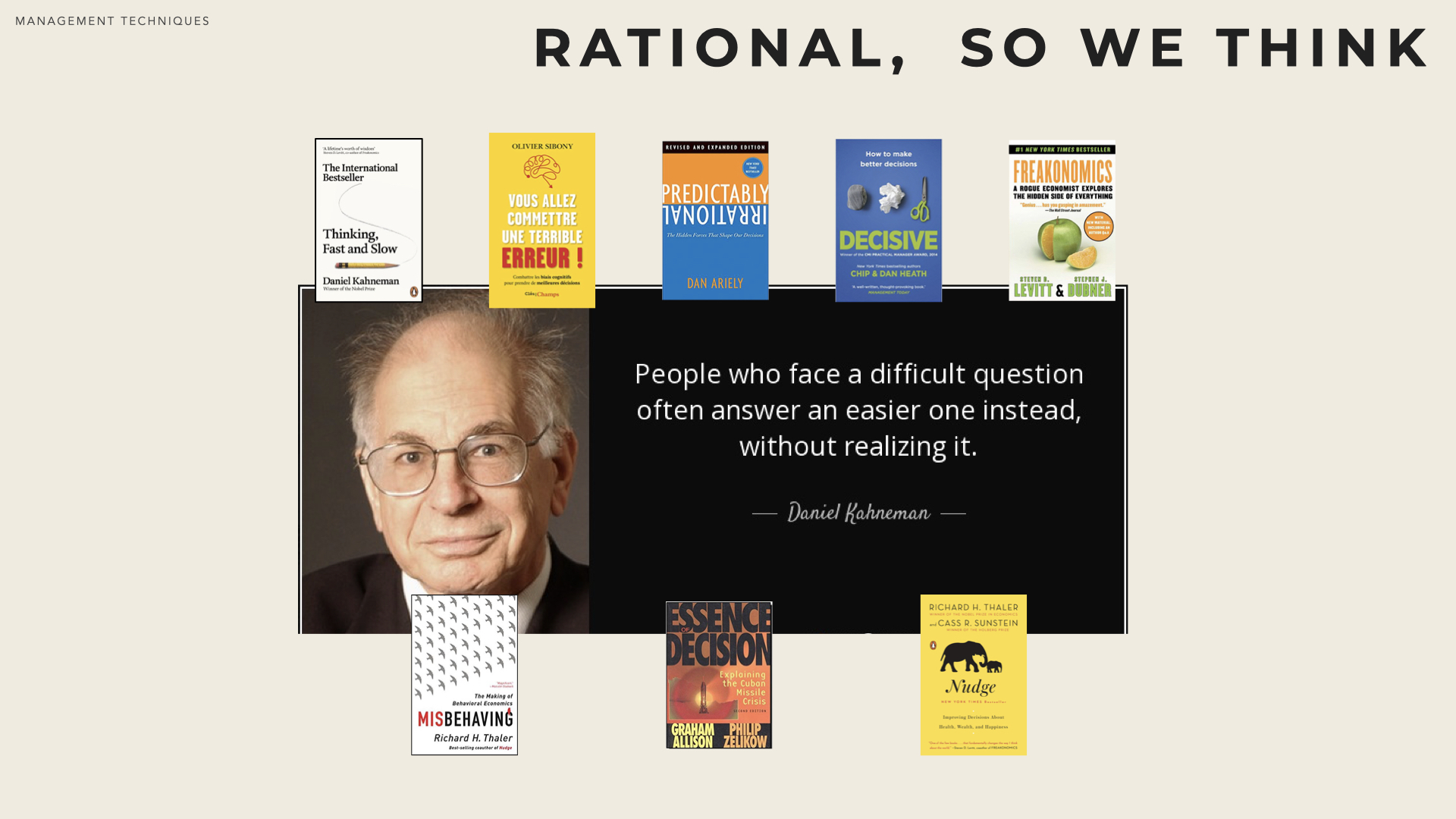
Several cognitive biases are frequent in strategy formulation:
Prior hypothesis bias - decision makers or analysts who have strong prior beliefs tend to disregard any evidence that their beliefs are wrong or should be nuanced. Conversely every element that confirms their prior beliefs are over-considered.
Escalating commitment - decision makers who have already committed significant resources to a project tend to react to feedback that the project is failing by committing even more resources. Similarly, in capital investment decisions, some people tend to consider what as been already spent whereas only future expenditures should be accounted for.
Reasoning by (inappropriate) analogies - can lead to seeking to solve complex problem with inadequate solutions (what worked in a given context may fail or even be counter-productive in a different context).
Illusion of control - the tendency (rather frequent in top management …) to overestimate one’s ability to control events. Overconfidence can lead to underestimating the importance of some factors (resources, environment changes, etc), overpricing acquisitions, overvaluing market forecasts, etc.
Probability - human beings are very bad at assessing probabilities and extremely prone at making reasoning fallacies (e.g. the tragic Sally Clark case
A cognitive bias is a systematic pattern of deviation from norm or rationality in judgment. Individuals create their own “subjective social reality” from their perception of the input [source wikipedia].
Alternatives to Rational Decision making
Management Scientists have elaborated many models that seek to reflect the way decision makers reach a conclusion ( [Allison99] [March93] [Cyert13] ) .
None of the model fully accounts for how strategic decisions are truly made (including sometimes wrongly made). However the variety of the models sheds some light on how complex (and counter-intuitive) decision-making can be in firms.
For instance, the garbage can model symbolises the choice-opportunity/decision-situation (for example: a meeting where ideas are discussed and decided on) as a “garbage can” that participants are chaotically dumping problems and solutions into, as they are being generated. The “garbage can” term’s significance is best understood by considering the manner in which items in a trash can are (dis-)organised, which is a messy, chaotic mix. The model portrays problems, solutions, and participants/decision-makers as three independent “streams” that are each generated separately, and flow disconnected from each other.
VUCA
VUCA (the acronym for volatility, uncertainty, complexity and ambiguity) has become very trendy in management conversations. It often comes for a handy excuse for not analysing a situation on the grounds that it is not stable enough to be studied.
In fact, four distinct types of situation - each requiring its own specific treatment - are designated by VUCA. The term initially introduced by the US Army War College to depict the post cold-war situation, became trendy in management since a decade or so (and often mis-used).
According to Bennet and Lemoine ( [Bennet14] ) any situation can be characterised according to i) available prior knowledge of its dynamics (how much can you understand how it can evolve - i.e. the consequences of your actions) and available insights about the situation (how reliable and relevant are facts & data).
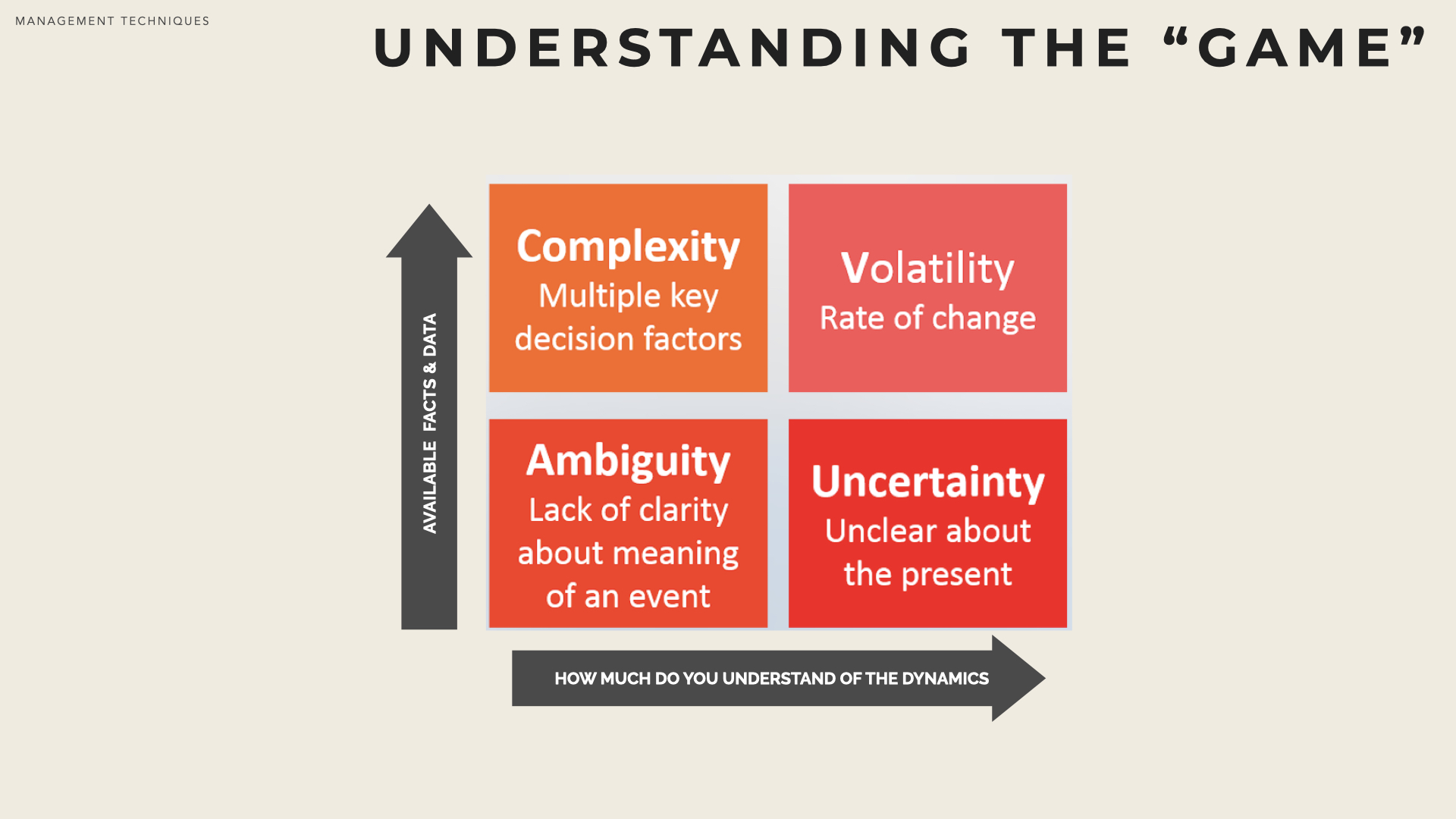
Four broad configurations (corresponding to the four quadrants) can happen.
- Uncertain: In this setup, the dynamics of causes and effects are well understood. However the current state and/or future events are unknown (their likelihood may be or may be not known).
Firms need to grow information and improve the quality of available information (sources, freshness) to reduce uncertainty. This is not a characteristic of the environment but rather of the perception of the environment by a given player. A situation can be seen as uncertain by some player and completely pre-determined by other (e.g. the launch of a new product).
- Ambiguous :the ‘rules of the games’ are unknown and therefore the consequences of actions and/or events are difficult to predict. Furthermore, the current state is not precisely known.
This is usually the sign for an unfamiliar environment and firms have to promote experimentation to gain more understanding of the environment and its dynamics.
- Complex: Although the current state can be reliably assessed, there are many inter-dependencies which leads to a highly dynamic behaviour and non-linear aspects (small modifications in inputs can create huge distortions in outcomes) with potential counter-intuitive outcomes.
It may also signal “complicated” situations with a lack of expertise (e.g. a firm moving to a new country).
- Volatile : Information is available and understandable. However, things can change and evolve very quickly (disruption). Volatility is a characteristic of the environment or situation. All players will confronted to the same degree of volatility (which doesn’t imply they will react equally).
Firms are seeking to grow their agility and flexibility in an attempt to cope with volatility.
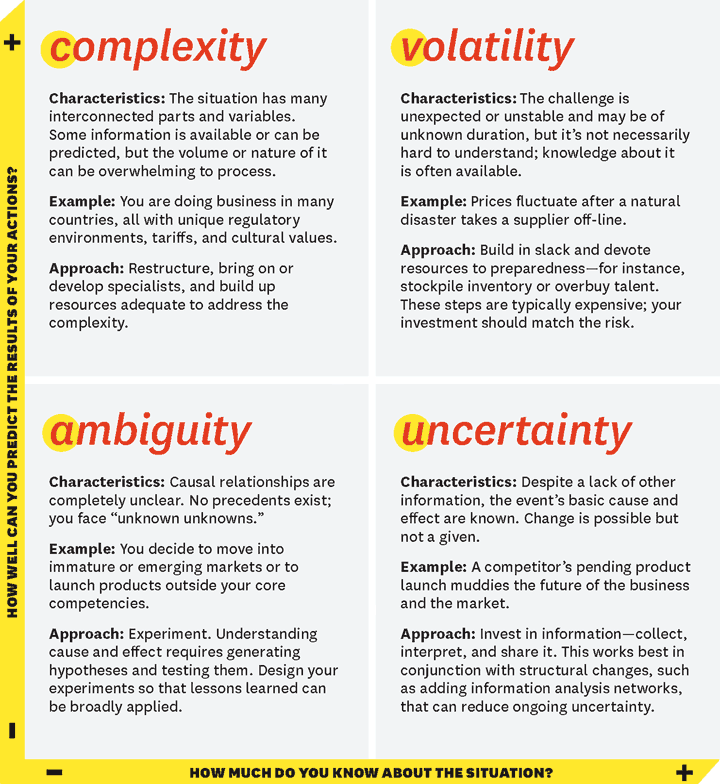
Thinking Method
Thinking requires more than one perspective
Western thinking mainly derives the truth from established facts and explicit inference rules. It focusses on ‘what is’ which is determined by analysis, judgement and argument (convergent thinking). However another whole aspect of thinking (constructive thinking, creative thinking, design thinking) deals with ‘what can be’ and identifying ways forward (divergent thinking).
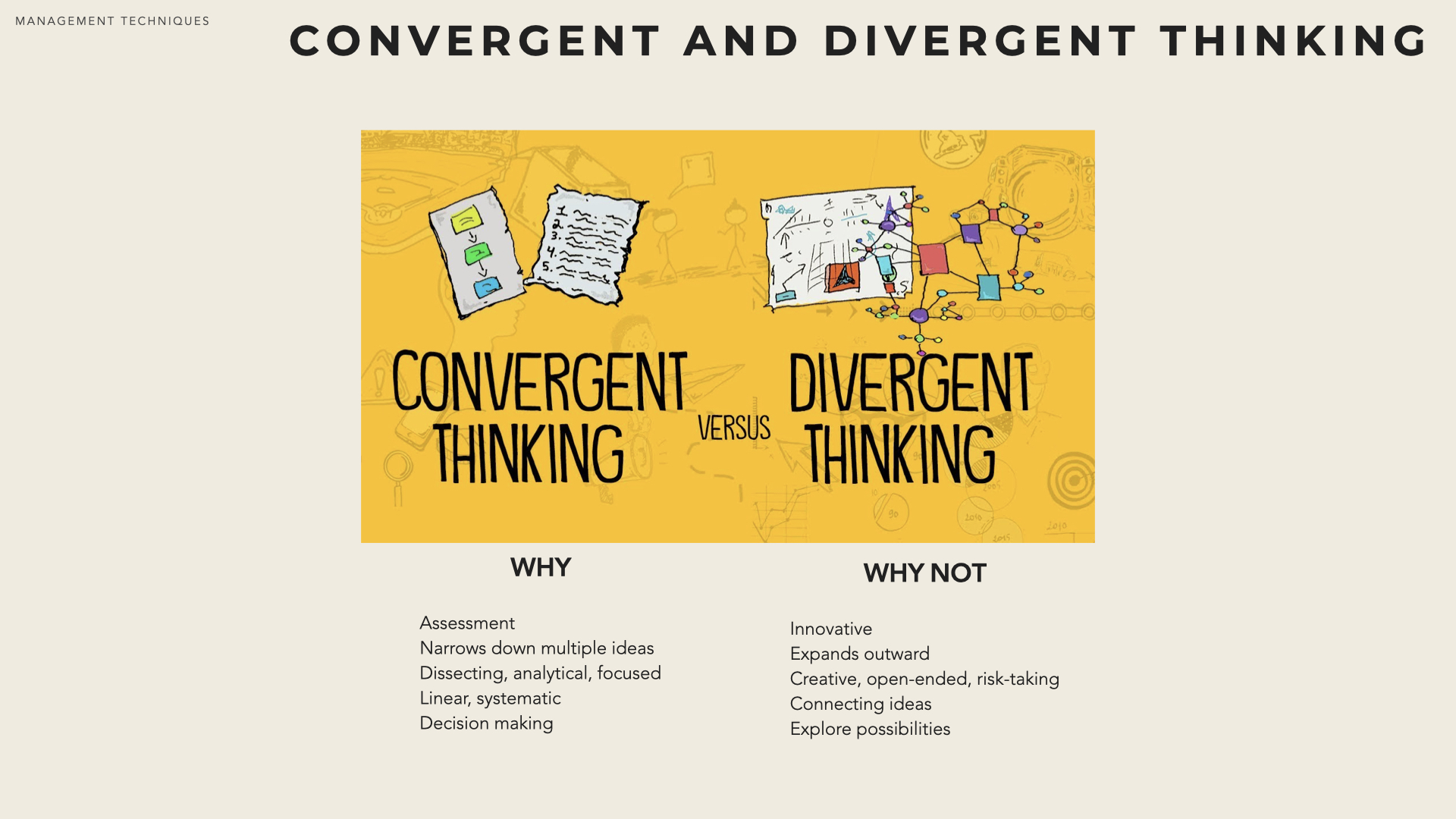
A thinking system based on argument is excellent just as the front left wheel of a car is excellent. There is nothing wrong with it at all. But it is not sufficient. — E. de Bono
Creativity (by the way, it seems that the word doesn’t exist in ancient Greek, where is rooted western thinking) requires other forms of thinking, such as intuition, opinions based on experience, feelings, impressions. Exploring many possible solutions and challenging the status quo is known as divergent thinking.
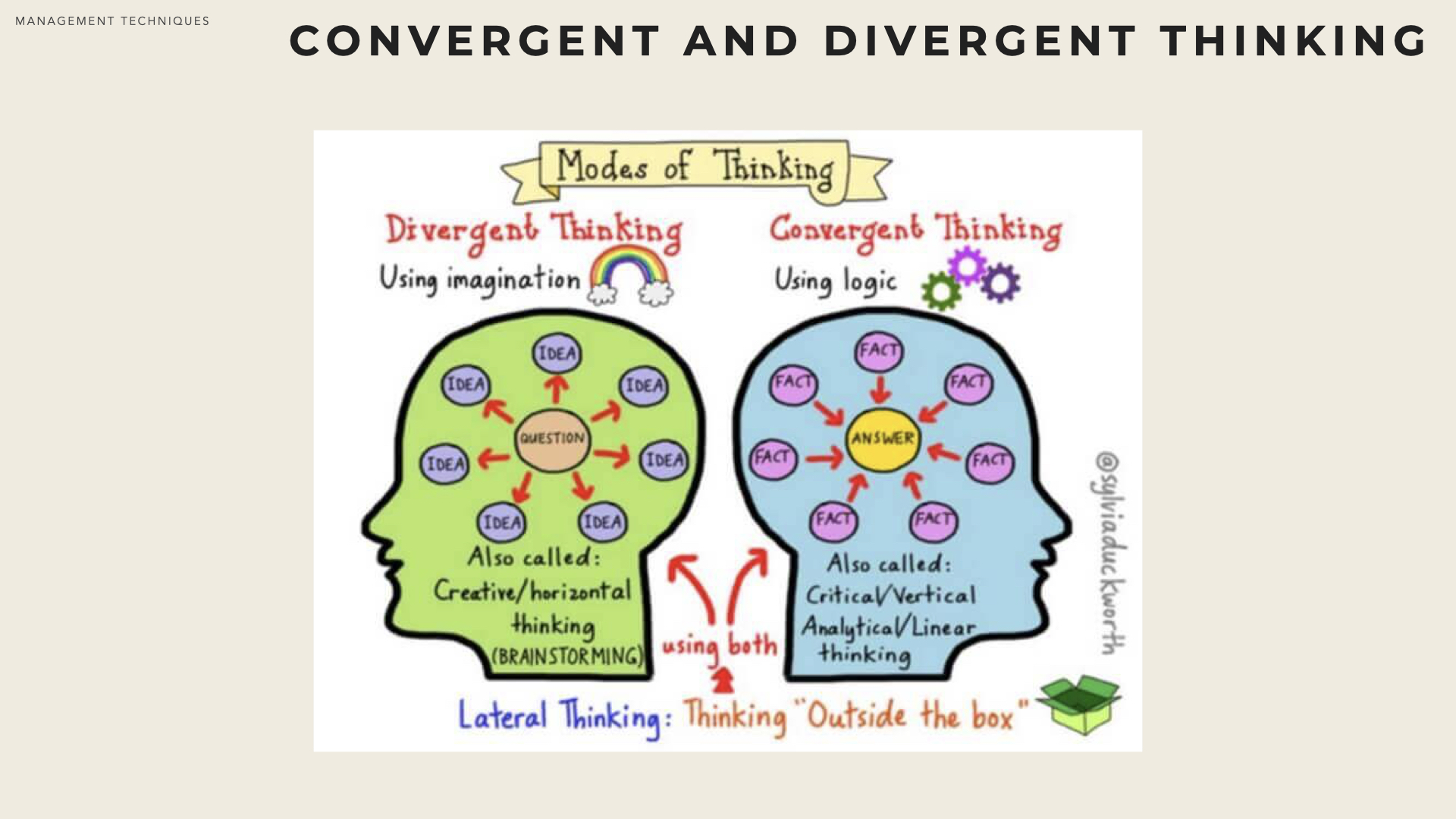
E. de Bono considers that Western Thinking works well in a stable world, where the standard situations of the past still apply. In a more volatile environment, instead of “judging” our way forward, we need to “design” our way forward, which calls for thinking about “what can be”” and not just about “what is” already.
Thinking as a Group Activity
E. de Bono ( [deBono85] ) stresses that more often than not, the underlying assumption is that reasonably intelligent people provided with enough background information will, in the course of a discussion, list the action options and choose the most suitable.
It often follows that those taking part to such discussions, already have the proposals from among which the solution is going to be chosen. By contrast, in the mind-making type of thinking the terrain is first explored, possible routes are observed and a final choice is finally made.
In fact, there are fundamentally four types of social attitudes in groups characterised by i) how much group members are committed to a common result (focus) and ii) how much group members are willing to consider different perspectives.

Disparate thinking Team members are not seeking to get to a common result. They may have different agenda or may be the join objective is too blurry or have not been defined. In addition, group members are looking at the situation from different perspectives. The approach is likely to be scattered, meetings will be unproductive, potentially frustrating, and will lead to nowhere.
Adversarial thinking Team members (at least some) are seeking to have their views prevail over others. This is a typically power game, confrontational, win-loose attitude. Opportunities can be missed, it is a waste of time, effort and brain power. Those who are more senior or the best at argument and debate will usually impose their views (agenda). Many political instances (e.g. parliament) or judiciary instances (criminal trial court) actually work like this.
Group-think thinking In this quadrant, team members agree on a common goal but they limit the diversity of their perspectives. It can be the sign of too much homogeneity in the group, or people trying to align with a senior member (e.g. their boss), or fearing to be seen as different or disruptive. It can also signal an attempt to avoid adversarial thinking. With Group-think there is usually very little exploration of potential outcomes and even less research of alternative means of achieving the outcomes.
Parallel thinking (a term coined by E. de Bono) seeks to benefit from both diverse perspective and single group focus. At all times the emphasis is on jointly designing a way forward. Diverse perspectives are encouraged and deliberately fostered. This is achieved by all the group examining the topic at hand from the same thinking perspective at the same time.
With parallel thinking they all walk around and look at the front. Then they all walk around to the side, the back and finally the remaining side. so at each moment each person is looking in parallel from the same point of view.
In parallel thinking, both views, no matter how contradictory are put down in parallel. If latter it is essential to choose between the different positions, then an attempt to choose is made at that point.
With the parallel thinking, a thinker shows off be showing how many considerations he or she can put forward under each hat. The difference is that that type if showing off is constructive. The ego is no longer tied to being right.
Western-thinking promotes confrontational adversarial thinking
E. de Bono also underlines that (some) people may use thinking to parade and show off how clever they are. In this type of thinking (aka argument mode) the purpose is to win, not to explore the subject honestly. Furthermore, if someone says something, the others feel they have to respond - even if only out of politeness. But that is not the case with parallel thinking.
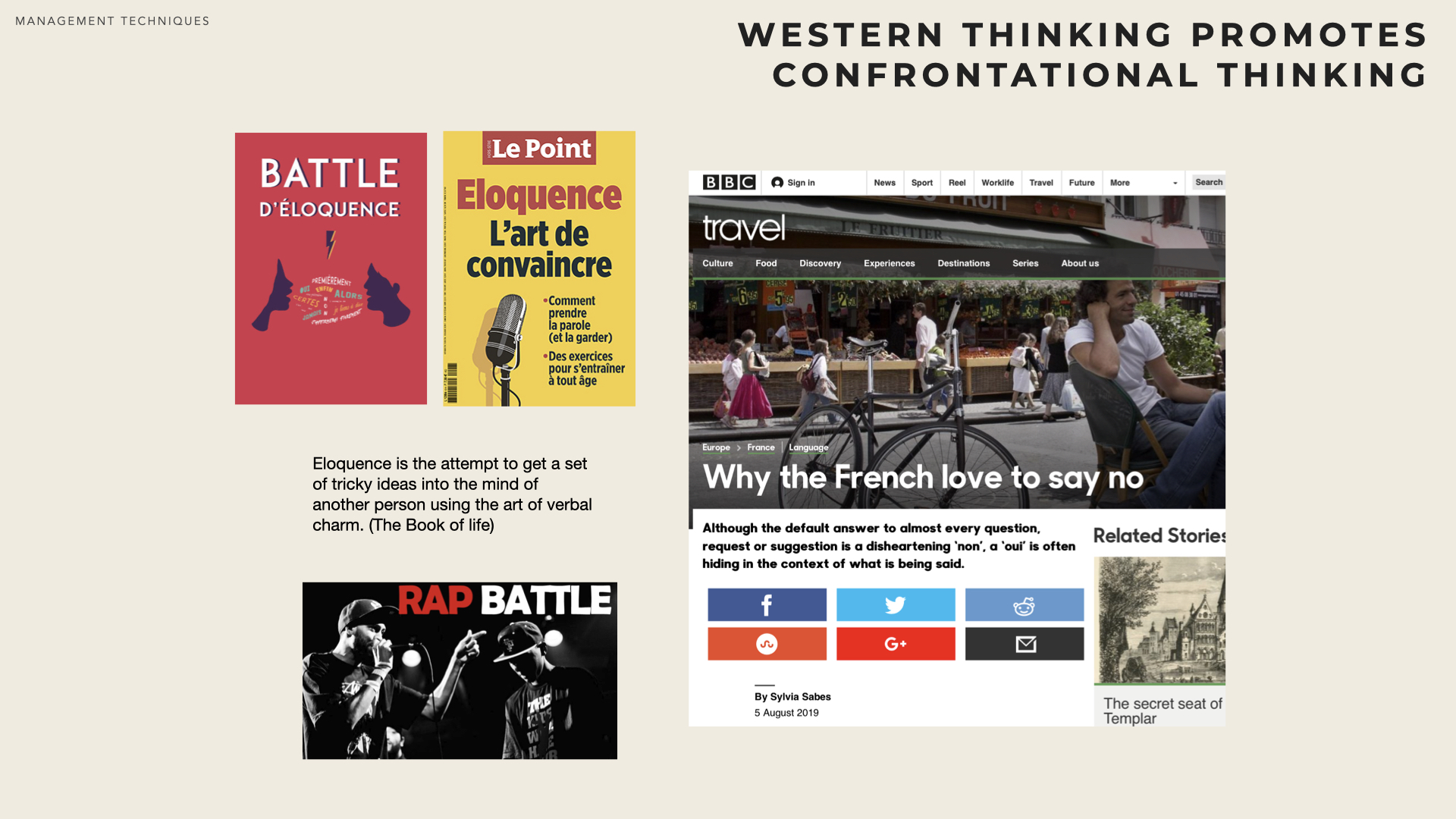
Adversarial thinking can exacerbate the ego problem and meetings can become very confrontational as people enjoy to contradict and demolish opponents. — E. de Bono
The Six Hats framework
Six Thinking Hats ( [deBono85] ) is a technique to help groups think more effectively as well as to improve individual thinking. While it was clearly not designed with strategic management in mind, it turns out to be particularly helpful to run strategic analyses and to support the formulation of strategies.
The method was designed by Edward de Bono (a Maltese physician and psychologist who specialised in Cognitive Science and Management). It is used both for parallel thinking (all the participants in a meeting are thinking in a cohesive way) and to unleash innovation (by removing censure and foster outside-the-box thinking).
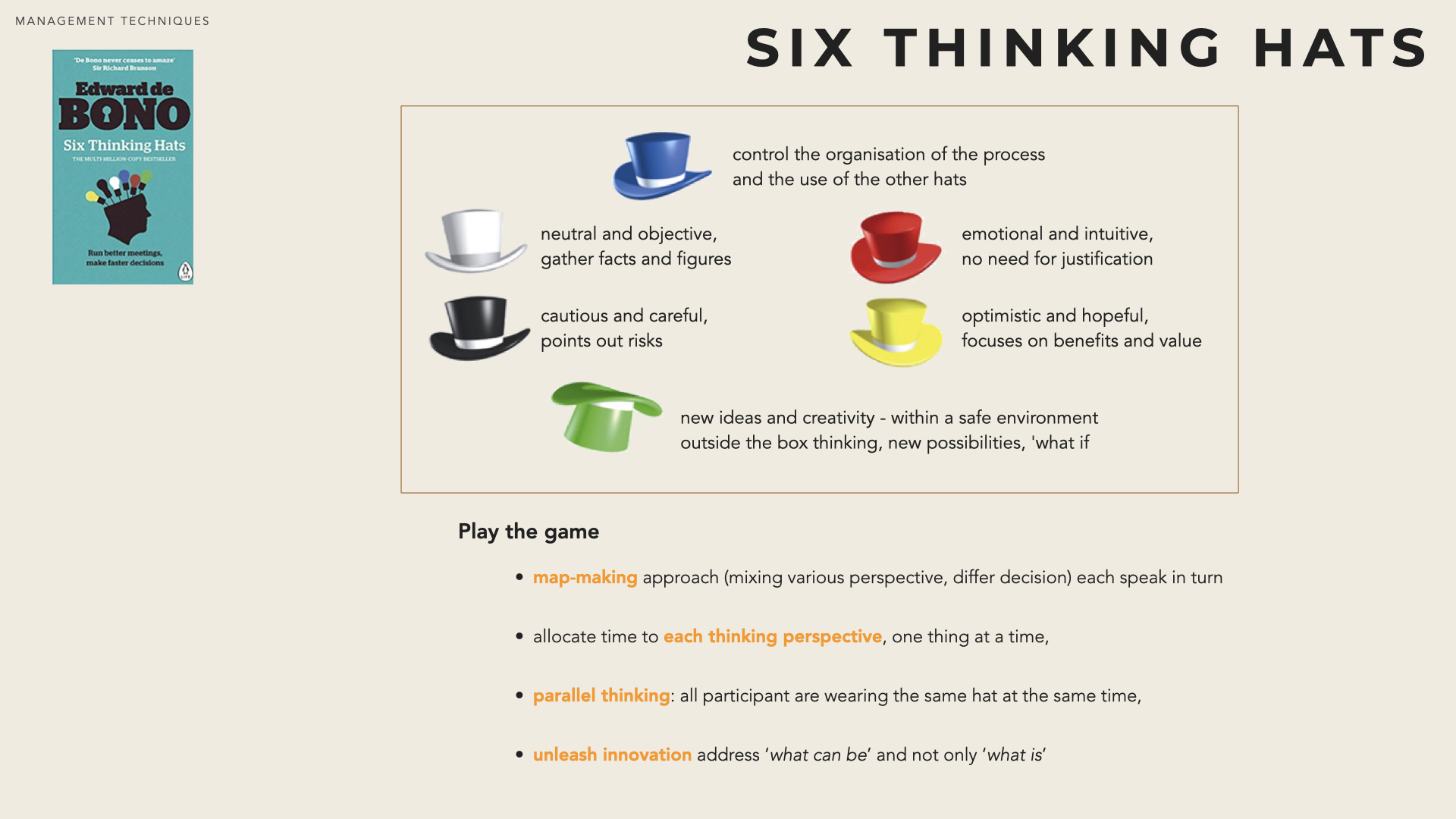
With the method it becomes easier to recognise the various types of thinking (as made by self or others) and therefore to embrace all perspectives. In meetings, people can be switched off their usual tracks and invited to think differently about the topics at hand.
Rather than letting people argue (where most people try to have the last say to their own satisfaction), they are guided through a non-confrontational thinking journey where the purpose is to consider all facets before any decision can be made.
The method foster a map-making approach where information mixing various perspectives (emotions, information, logic, etc…) gradually organises itself into an idea.
The method ensure the right balance of perspectives. Rather than doing a bit of everything it promotes doing a lot of everything but in distinct time slots. A powerful way of treating opposing ideas is to suppose that each one is correct under certain circumstances. The same approach can also be sued in the evaluation of ideas by using the ‘best home’ method. What would be the best home for that idea?
Parallel thinking and the hats is a way to mobilise energy on solving problems and creating solutions.
With the Six Hats method, the intelligence, experience and knowledge of all the members of the group are fully used. [de Bono]
The hats and their functions
A hat as a symbol (visible to everyone around) is that indicates a role. When a hat is worn, then that specific way of thinking must be triggered and exclusively used. In practice the hats are always called by their colour and never by their function. It ensures neutrality and avoid any connotation. E.g. Take off the black hat for a moment (rather than stop being cautious). Insisting on the game of the six hats can also be very powerful in getting people to play the game and changing behaviour.
People may prefer one mode of thinking to another. They might even be better at one mode that another. Nevertheless everyone present wears the same hat at the appointed time.
There are two basic ways of using the hats. A hat can be used simply to request a type of thinking. Hats can also be used in a sequence to explore a subject or solve a problem.
In group sessions, each participant has one minute to express an idea (in the tone of the hat). When all the participants have spoken and if genuine ideas are still being put forward, the time can be extended.
As stressed by E. de Bono: it is much better to set a short time and to extend the time rather than set a long time and have people sitting around wondering what to say.
Individual thinking (particularly with the green, yellow and black hats) can be blended in group discussions e.g. « we are now switching to the yellow hat. I want you to spend two minutes thinking on your own before we open the discussion ».
Blue Hat Thinking
Blue Hat Thinking is for thinking about thinking. It is for the organisation of thinking and process control. It sets the thinking strategy. When we are wearing the blue hat (it is typically worn by the facilitator or leader of the session) we are no longer thinking about the topic at hand but instead we are thinking about the thinking needed to explore that topic.

Blue Hat Thinking should typically be used at the beginning and at the end of a session:
At the beginning of the session, the focus is on how to handle the situation: definition of the situation, clear problem statement, what do we want to achieve, where do we want to end up, what is the background to the thinking, what is the detailed plan for the sequence, including what should be happening and hats to be used.
At the end of the session, Blue Hat Thinking is used to conclude and stress what has been achieved, to articulate the precise outcome, agreement or conclusion and possibly to agree on next steps.
The framing and focus of a question is an important aspect of Blue Hat Thinking. According to de Bono, questions can be grouped into ‘*fishing questions*’ (exploratory mode) or ‘*shooting questions*’ (with direct yes or no answer). He insists that rather than trying to define the best problem definition beforehand, it can be more efficient to identify a range of alternatives instead. It is also paramount to stick with the real issue and not to drift.
“The problem is not that we have no snow but that we have no skiing” — E. de Bono
Blue Hat Thinking controls the use of the various hats, it monitors the thinking and ensures that the rules of the game are observed.
White Hat Thinking
White Hat Thinking deals with facts and figures reported in a neutral and objective manner. It allows the establishment of an inventory of available information and helps with identifying missing information and articulating questions to be asked.

When facts are not known for sure (i.e. some confirmation is required), it may be wise to split checked facts from unchecked facts. White Hat Thinking shall not determine how missing information can be fetched (this is a task for other hats - e.g. the Blue or Green Hat).
White hat thinking becomes a discipline which encourages the thinker to separate quite clearly in his or her own mind what is fact and what is extrapolation or interpretation. — E. de Bono
Facts should be reported independently of any (hidden) agenda. Too often facts and figures are presented (and thought of) as part of a justification: they are intended for some purpose rather than presented as facts.
If relevant, a feeling expressed by someone else can be reported as a fact. However your own emotions or opinion (including about facts) must be dealt with exclusively under the Red Hat.
There should be no contradictory debate under the White Hat. If two pieces of information are not consistent, they should both be recorded and a choice will be made (Blue Hat) only if and when it becomes essential to choose between them.
Black Hat thinking
The black hat is the hat of caution. It stops us from doing things that are illegal, dangerous, unprofitable, polluting, etc. It is a very important hat provided that ‘being careful’ doesn’t get overused, misused or abused (the famous ‘yes, but …’).

The Black Hat corresponds to what cognitive science calls the “mismatch” mechanism. The brain forms patterns of expectations (i.e. anticipations on what the world is). When something doesn’t match these patterns, we feel uncomfortable and get alerted. This natural mechanism ensures that we limit mistakes and avoid what could be dangerous or at the extreme become detrimental to our own survival.
The black hat stresses something that doesn’t fit our resources, our policy, our strategy, our ethics, our values , and so forth. [de Bono]
Although the mismatch mechanism is globally unconscious, Black Hat thinking must explicitly articulate logical reasons, capable of standing on their own (i.e. play the Devil’s advocate: “what is the downside”, “what can fail” ).
Black Hat reasons must make sense and must be reasonable in cold print, not only when presented by a persuasive person. – E. de Bono
Black Hat Thinking is key to points out what is wrong (or could be wrong), what doesn’t fit, and what will not work (i.e. it corresponds to critical thinking - another jewel from Greek philosophy). It aims at establishing a clear map of potential problems, obstacles, difficulties and dangers. Other hats (e.g. Green Hat) can then look for ways to cancel drawbacks.
A practical way to stress that an assessment is done under the Black Hat is to start statements with ‘I see a danger that …’.
Under the black hat it is possible to point out deficiencies in the thinking process itself.
Yellow Hat Thinking
Under the Yellow Hat, thinkers seek to identify benefits. It is a judgement hat (rather than a fantasy hat) with a clear bias towards positive interpretation: looking for value and additional opportunities.

While Black Hat Thinking is about risks and caution (it covers the aspect of critical thinking) Yellow Hat Thinking is deliberately about optimism and being sensitive to value.
Being positive is a choice. We can choose to focus on those aspects of a situation that are positive. We can search for benefits and spend time seeking out value. — E. de Bono]
Any suggestion should be submitted to both Yellow Hat and Black Hat assessments. More globally, Yellow Hat Thinking deals with the positive assessment of existing proposals, the generation of new proposals or the enhancement of proposals. Nevertheless Yellow Hat Thinking remains logically based (i.e. some reason for value should be put forward).
Yellow Hat Thinking can also be speculative and looking for pure ‘opportunities’. In that respect, the best possible scenario must first be delineated and positively assessed with Yellow Hat Thinking. If benefits are not sufficient (even with the best possible scenario where benefits should be maximum) then the idea is not worth pursuing. Otherwise, the assessment must continue with some Black Hat Thinking to identify potential drawback, assess feasibility and determine the most likely scenario.
The speculative aspect of yellow hat thinking is also concerned with ‘vision’ and ‘dreams’ (i.e. setting far reaching goals) and with setting direction for further thinking and for action.
In any design there is some sort of vision that comes first. Just as as good salesman makes a sale by putting forth a marvellous vision which the client is invited to share, so the designer sells himself a positive vision of what he is trying to do. The vision comes first and then the form and detail follow. The vision includes both the benefits and the feasibility of the project: it can be done and it is worth doing. [de Bono]
Nonetheless, Yellow Hat Thinking is not directly concerned with ‘pure creativity’ (even though the positive assessment and constructive aspect of Yellow Hat Thinking are vital to creativity). Yellow Hat Thinking fosters a positive attitude, it identifies opportunities and possibly can replicate ideas borrowed from elsewhere. However it is not concerned with changing concepts or perceptions, which is left to Green Hat Thinking.
Red Hat thinking
Red Hat Thinking focuses on articulating intuition, emotions and feeling without any need for explanations, justifications or qualifications. The purpose is to express feelings as they exists - not to force a judgement.

Red Hat Thinking is very much linked to perceptions. Thinking can change emotions. It is not the logical part of thinking that changes emotions but the perceptual part.
Red hat is the opposite of neutral and objective information (white hat). It gives official permission for the expression of feelings that range from pure emotion to hunch. — E. de Bono.
Red hat feelings can be shown at any time in the course of a meeting, a discussion or a conversation. The feelings can be directed at the Conduct of the meeting itself, not just the subject matter that is being discussed.
« I want to lake a red hat statement. I feel we are being bullied into an agreement we do not want. »
« I want you to put on your red hat and tell me what you think about my proposal ».
« Can we just have one overall red hat statement from you, and then we’ll leave it. what do you feel about the matter? ».
We are brought up to apologise for emotions and feelings because they are not the stuff of logical thinking. That is why we tend to rationalise and treat them as an extension of logic. (If we dislike someone; there must be a reason. If we like a project, this must be based on logic.
The most difficult thing about wearing the red thinking hat is resisting the temptation to justify an expressed emotion. Such justification may be true or may be false. In both cases red hat thinking makes it unnecessary.
The red hat covers two broad types of feeling. first, there are the ordinary emotions such as fear and dislike to more subtle ones such as suspicion. Second there are the complex judgements that go into such types of feeling as hunch, intuition, sense, taste, aesthetic feeling and other not visibly justified types of feeling. Where an opinion has a large measure of this typer of feeling, it can also fit under the red hat.
A red hat may be used immediately after the first blue hat. This is done in situations where it is believed that there are already strong feelings on the subject (e.g. fear, anger, hatred, suspicion, jealousy or love). The purpose is to make visible this background so that its subsequent influence can be observed.
Green Hat Thinking
Green Hat Thinking addresses creativity, which includes new ways of looking at things (change, innovation, invention). It aims at putting forward alternatives, suggesting new ‘possibilities’ and improving existing ideas. It looks at how things could be done in a simpler or more efficient way.

The green hat device allows us to switch into the creative role just as the red hat allows us to switch into the ‘feeling’ role and the black hat into the ‘caution’ role. A specific time is set out for everyone to make a creative effort. Everybody is expected to make a creative effort or keep quiet. As people don’t like keeping quiet, so they make creative efforts. [de Bono]
Green Hat Thinking can help overcome difficulties identified by Black Hat Thinking or leverage opportunities unveiled by Yellow Hat Thinking.
Creativity is more than just being positive and optimistic it often requires changing perceptions and coming out with new concepts. It may include putting forward ideas that are deliberately illogical. The Green Hat can be used as a signal (to others as well as to oneself) that non-conventional thinking is on-going. — E. de Bono